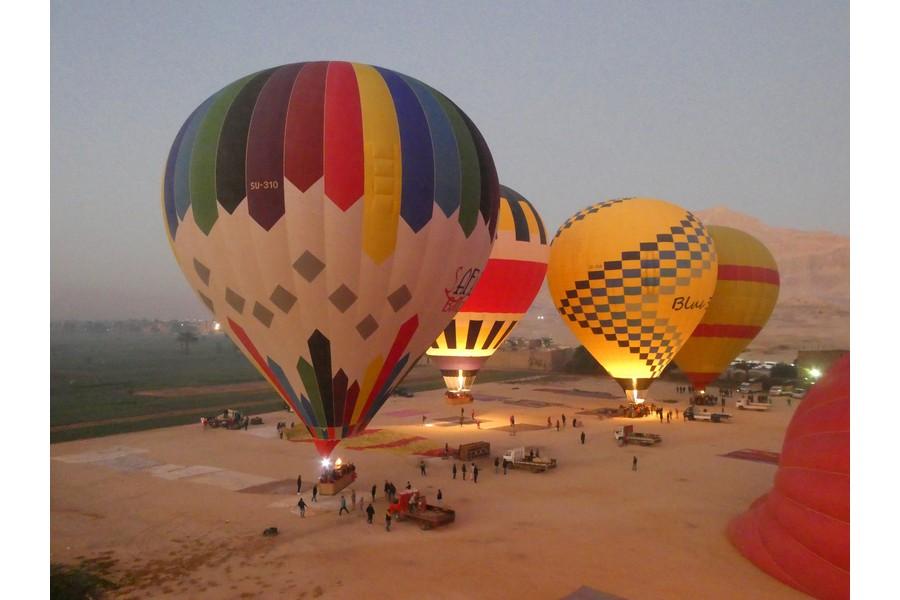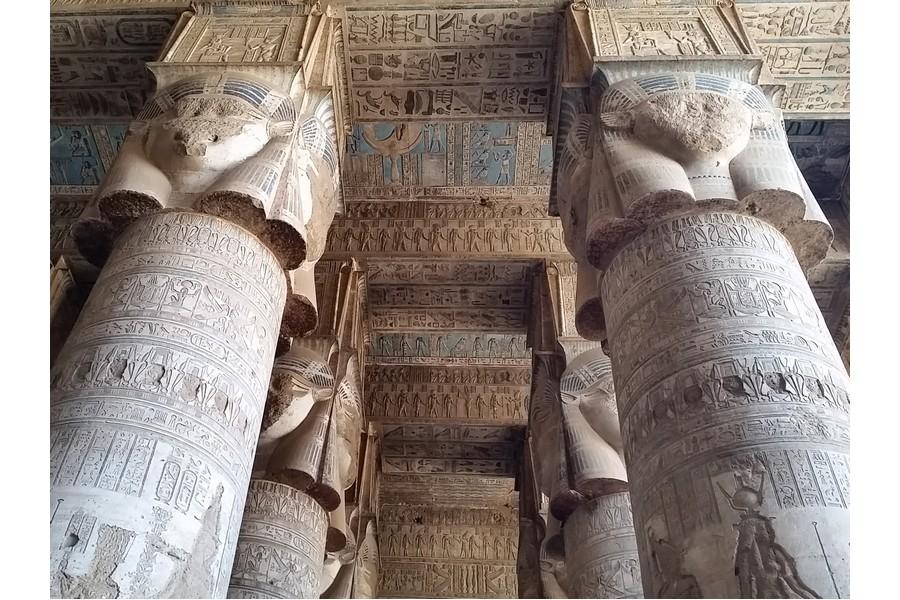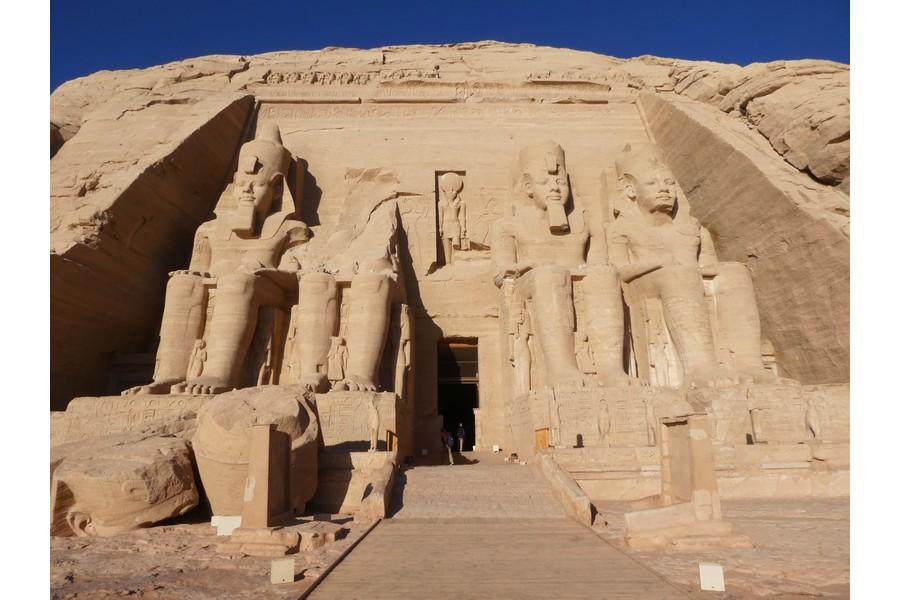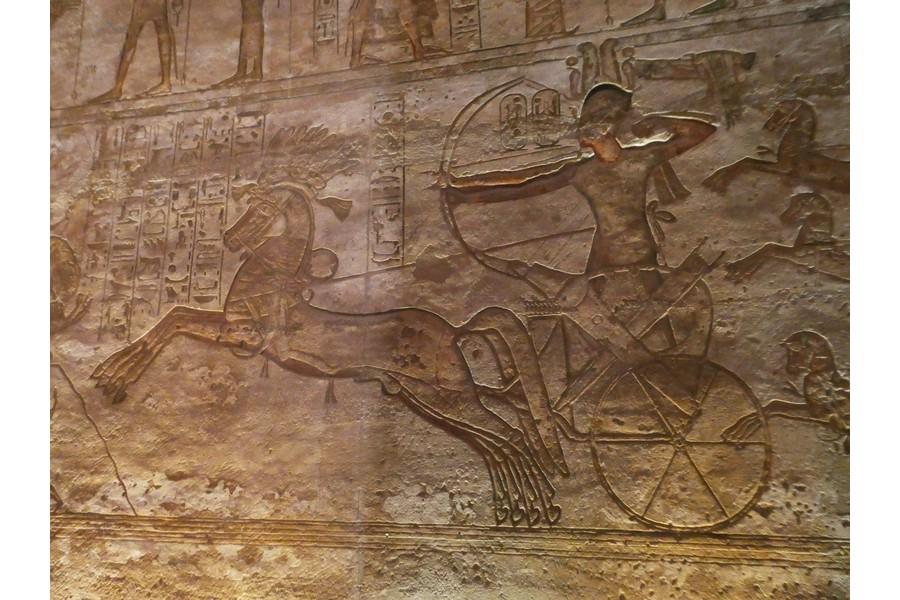Seeing is believing
Country
We’ve all heard about Egypt, Tutankhamun, Pharaohs, the Great Pyramids, hieroglyphs, the Nile, scribes, Luxor and Aswan, but it’s not until you visit, that you begin to connect some dots.
The most mind blowing thing for both of us was to stand in front of walls of meticulously carved hieroglyphs, and to come to understand that walls, buildings, monuments, and even the Great Pyramids in Giza were all covered in colour. It’s hard to imagine the rich, colourful and vibrant place Ancient Egypt once was.
We braved a taxi who took us to our “new” Queens Valley Hotel Luxor with private bathroom. Well, the hotel wasn’t new, in fact it was very old. The first room they put us in had twin beds (not what was booked), so it took a little while for them to make up a double room complete with a swan shaped towel on the bed. Come time to have a shower, our private bathroom had water, but no hot water. We didn’t want to move from this room, fearing something worse, so they gave us the key to a nearby room to have hot showers. On the plus side, the staff were very attentive, a bit like in a Faulty Towers kind of way. The barman was always wanting us to join him at the bar for some alcohol, and Ahmed hovered at every turn wanting to know in broken Arabic whether everything was OK. It turned out to be quite a fun, quirky place to stay. Besides, our bedroom window overlooked the Avenue of the Sphinxes, a 3km ancient processional route that once linked Luxor temple with Karnak temple.
The quantity and quality of sights you can visit in Egypt is overwhelming so through Freedom Hostel in Cairo, we hired a guide in both Luxor and Aswan to ease the pain of managing everything ourselves. Our first day in Luxor was spent exploring the magnificent Karnac Temple, then later in the afternoon, the Luxor Temple. The next day began with a sunrise balloon adventure towards the Valley of the Kings – the eternal resting place of the pharaohs. We’d not ever experienced a hot air balloon ride before and luckily we had an experienced operator who could land a balloon safely, unlike our Japanese friend from the Freedom Hostel who said her balloon landed in a field of banana trees!
At the Valley of the Kings, we entered four tombs – Ramesses IV, Ramesses III, Tuthmose I and Seti II. I’d have to say the grandeur of the tomb of Ramesses IV was one of the highlights of our whole visit to Egypt. The walls were ablaze with colour, the carvings were precise and perfectly formed, and the long walk down and through the four chambers was a journey into another world.
It’s often the case that if you want to take photographs at sights you need to purchase an additional ticket. If you don’t have a ticket, guards will ask you to delete images and sometimes hold onto your camera or phone. At the Valley of the Kings, the price, on top of the normal ticket was $30. We chose not to spend this extra money as we knew about the baksheesh (back hander) system and thought we could manage paying willing guards to turn a blind eye. This worked to some degree, but I ended up handing out a total of $16 for snatched photographs instead of succumbing to paying $30 for the freedom to snap away everywhere. After a while I felt like a friend who once said “I was in such a baksheesh giving frenzy that even the street sweeper could have shaken my hand and ended up with a few notes in his palm”!
We visited Deir el-Medina, an ancient Egyptian village which was home to the artisans who worked on the tombs in the Valley of the Kings during the 18th to 20th dynasties of the New Kingdom. “At the time when the world's press was concentrating on Howard Carter's discovery of the Tomb of Tutankhamun in 1922, a team led by Bernard Bruyère began to excavate the site. This work has resulted in one of the most thoroughly documented accounts of community life in the ancient world that spans almost four hundred years. There is no comparable site in which the organisation, social interactions, working and living conditions of a community can be studied in such detail. The settlement was home to a mixed population of Egyptians, Nubians and Asiatics who were employed as labourers (stone-cutters, plasterers, water-carriers), as well as those involved in the administration and decoration of the royal tombs and temples.” We discovered these tombs were proof that workers were not slaves. Further that builders would build the tombs for the artisans, and the artisans would decorate the tombs for the builders.
On our third day in Luxor, a guide and driver took us to what is considered one of the most important archaeological sites in Egypt, the sacred city of Abydos. Abydos is notable for the memorial temple of Seti I, which contains an inscription known to the modern world as the Abydos King List, a chronological list showing cartouches of most dynastic pharaohs of Egypt. After Abydos, we visited the Temple of Hathor in Dendera before needing to be cleared by the police to drive back along the main road to Luxor. Everywhere you go, Egyptian security wants to know the whereabouts of visitors.
As the train system had been such a success, we took the four hour train from Luxor to Aswan. Our three star accommodation at the Nile Hotel had 180 degree views over the Nile River, so anything else they didn’t do to any appropriate standard, didn’t matter!
Again, we took the easy option of having a guide take us around Aswan. Our first stop was to inspect the Aswan High Dam. Construction began in 1960 and the dam was officially opened in July 1970. The new dam would not only increase the amount of farmland, but irrigation would become a reality and the annual production of electricity would be increased. The new body of water formed the 500km long Lake Nasser. Not everyone was happy with the result. The new dam flooded all of Lower Nubia where the inhabitants became homeless and were mostly resettled in the areas of Aswan and Kom Ombo.
We caught a boat to visit the magical island temple of Philae. With the threat of flooding and changed water channels, before the 1970 completion of the Aswan High Dam, the temple complex was dismantled and moved to nearby Agilkia Island as part of the UNESCO Nubia Campaign project.
A must do in Aswan is to watch feluccas, simple traditional Egyptian sailboats, sail by as the sun slowly sets over the Mighty Nile. This we did from a balcony of the grand Cataract Hotel with a couple of splendid G&T’s in hand. With the little cash we had left after just two G&T’s, we called into a street side café on the way home for cheap pizzas. We believe we had our priorities in order!
On our last day in Aswan, we got up at the crazy hour of 4am in order to bus the 280kms to Abu Simbel, the most beautiful and imposing construction of Ramesses II. Abu Simbel is situated in the heart of Nubian territory, almost on the border with Sudan. We travelled in convey under police escort, and had a tea break just as the sun was greeting the new day over the Eastern Desert.
With the building of the new dam, the temples of Abu Simbel were also in danger of disappearing under the waters of Lake Nasser. In 1959, UNESCO received an official request from the Egyptian and Sudanese governments regarding the rescue of the unique temples. Between 1964 and 1968, the entire site was carefully cut into large blocks, dismantled, lifted and reassembled in a new location 65 metres higher and 200 metres back from the river, in one of the greatest challenges of archaeological engineering in history.
This time around, we paid the extra $30 for the photography ticket and boy did I take great pleasure in flashing that little ticket everywhere when a guard thought he could make some baksheesh by catching me in the act of taking a photo when I shouldn’t have!
After an afternoon nap, we found a lovely Nubian felucca captain who took us on a scenic cruise around the channels of the Nile as the sun set on our last night in the Upper Nile.
Another epic train journey and we were back in Cairo, in our double room at the Freedom Hostel…
For the history buffs –
Second Intermediate Period (1640-1520 BC) Dynasties XV-XVII
The Middle Kingdom ends and the Second Intermediate Period begins. Some of the dynasties at the end of the middle kingdom and during this period only last for a short time. The horse and chariot are introduced during this period.
New Kingdom (1520-1075 BC) Dynasties XVIII-XX
The New Kingdom is the time of greatest prosperity for the Ancient Egyptian civilization. During this time the Pharaohs conquer the most lands and the Egyptian Empire reaches its peak.
1520 B.C. - Amhose I reunites the kingdom and the New Kingdom begins.
1506 B.C. - Tuthmosis I becomes Pharaoh. He is the first to be buried in the Valley of the Kings. For the next 500 years this will be the main burial area for the royalty of Egypt.
1479 B.C. - Hatshepsut becomes Pharaoh. She is one of the most successful woman pharaohs and rules for 22 years.
1386 B.C. - Amenhotep III becomes Pharaoh. Under his reign the Egyptian civilization would reach its peak in prosperity, power, and art. He builds the Temple of Luxor.
1352 B.C. - Akhenaten changed the Egyptian religion to worship a single god. This was a major change of life. It only lasted for his rule however, as his son Tutankhamun would change the religion back to the old ways.
1279 B.C. - Rameses II becomes Pharaoh. He would rule for 67 years and build many monuments.
Third Intermediate Period (1075 - 653 BC) Dynasties XXI-XXIV
The New Kingdom comes to end when Egypt becomes divided. Third Intermediate Period begins. Egypt grows weaker and is eventually conquered by the Assyrian Empire near the end of this period.
Late Period (653 - 332 BC) Dynasties XXV-XXX
The late period begins as the Assyrians leave Egypt and the locals regain control from vassals left by the Assyrians.
525 B.C. - The Persians conquer Egypt and rule for over 100 years.
332 B.C. - Alexander the Great and the Greeks conquer Egypt. He founds the great city of Alexandria.
Ptolemaic dynasty
305 B.C. - Ptolemy I becomes Pharaoh and the Ptolemic period begins. Alexandria becomes the new capital.
30 B.C. - The last Pharaoh, Cleopatra VII, dies.
Comments
Thanks Grant. We said the same thing to ourselves! See you in Boonah next month :)
We can't be there, with 25 events it's impossible, both time wise and budget. :( We even have three events on three continents on the same weekend!
Sorry, maybe somewhere else someday!










































Well done, great pics! Makes me want to go back and see what I missed! :)